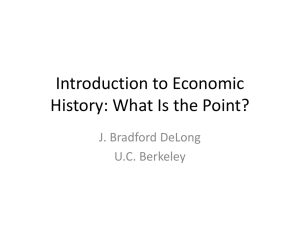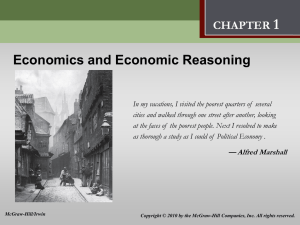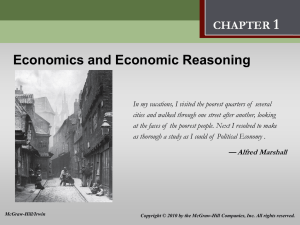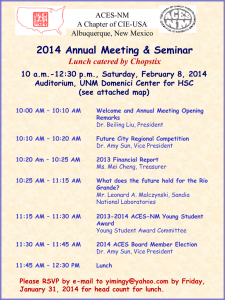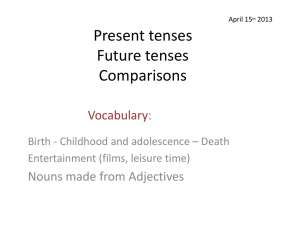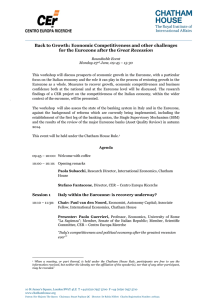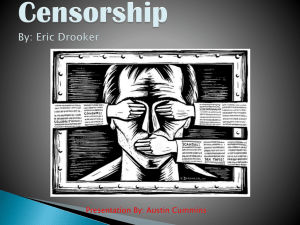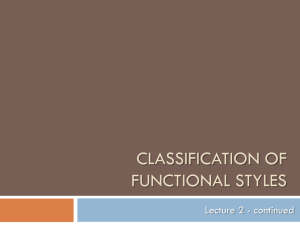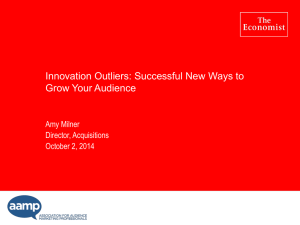The Economist
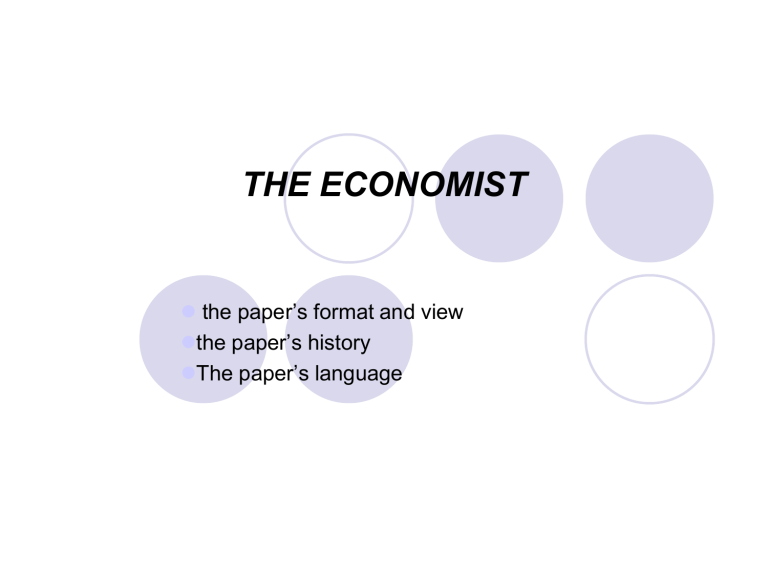
THE ECONOMIST
the paper’s format and view
the paper’s history
The paper’s language
THE NEWSPAPER
TYPE: a weekly magazine
FORMAT: magazine (berliner format)
OWNER: half shares have been owned by The Financial Times , half by the members of the paper’s staff
EDITOR: John Micklethwait (2006-present)
FOUNDED: in September 1843 to take part in a severe contest between intelligence, which presses forward, and an unworthy timid ignorance obstructing our progress
HEADQUARTERS: 25 St James, London SW1A 1HG England
WEBSITE: www.economist.com
. It is the premier online source for business and current affairs. It has offices in New York, London and San Francisco.
THE NEWSPAPER: THE LOGO
The corporate logotype has evolved from the gothic letterring used on the cover of the first issue published in 1843 to the box device designed in 1959 by Reynolds Stones, a British engraver and typographer.
It now incorporates a font from the Economist typefamily , a typeface created specifically for the paper use (1991):
• Officina is used for the cover headlines
• Ecotype is used for the paper
THE NEWSPAPER: OWNERSHIP
The company is private. The share capital is divided into shares A
(special shares) and shares B (special shares and trust shares).
The general management of the business of the company is under the control of the board of directors.
There are 13 seats on the board, 7 of which may be appointed by the holders of the A special shares, and 6 by the Holders of the B special shares.
The Financial
Times , which holds half shares, is entitled to appoint less than half of the board.
THE NEWSPAPER: SHARES
Ordinary shares are principally held by employees, past employers and founding members of the company. The transfer of ordinary shareholders must be approved by the board of directors.
1.
A special shares are held by individual shareholders including the
Cadebury, Rotschild, Schroder, some members of the staff, and former staff shareholders.
THE NEWSPAPER: SHARES
1.
B special shares are held by The Financial Times (50% of the total share capital)
2.
Trust shares are held by trustees, whose consent is needed for certain corporate activities, including the transfer of A and B special shares.
The appointment of the editor of the paper and of the chairman of the company are subject to the approval of the trustees.
THE NEWSPAPER
It calls itself a newspaper and refers to its staff as correspondents, it is printed in magazine form on glossy paper, like a newsmagazine.
Since when it incorporated The Banker’s Gazette and The Railway
Monitor (1845-1932), it described itself as a political, literary and general newspaper. It still does so because, in addition to offering analysis and opinion, it tries in each issue to cover the main events, business and political of the week.
THE NEWSPAPER ON PRESS
It goes to press on Thursday (6-7 p.m. London time) and it is printed simultaneously in six countries; it is available in most of the world’s main cities the following day or soon after.
Every week in Great Britain readers get a few extra pages devoted to British news.
Every two weeks the paper includes an additional section, an indepth survey of a particular business sector or geographical region.
Every three months it publishes a technology survey.
THE NEWSPAPER VIEW
It takes a strongly argued editorial stance on many issues, especially its support for free trade and fiscal conservatorism.
Its subjects cover national and international news about:
Economics
Politics
Finance
Business
Science
Technology and arts
THE NEWSPAPER VIEW
Political allegiance : economic liberalism, moderate liberalism, extreme centrism;
Opinion columns: each is devoted to a particular area of interest;
BAGEHOT (Britain) it is named after its third editor, a XIXth century British constitutional expert;
CHARLEMAGNE (Europe) named after the founder of the
Roman Empire;
LEXINGTON (USA) named after the site of the beginning of the
American War of Independence, the Massachusetts.
THE NEWSPAPER VIEW
BUTTONWOOD (finance) it is named after the buttonwood tree where early Wall Street traders used to gather.
FACEVALUE it is about prominent people in the business world.
ECONOMICS FOCUS it is about general economics.
THE NEWSPAPER VIEW
It generally supports free markets and opposes socialism.
It is in favour of globalisation and free immigration.
It supports social liberalism , which is often seen as left-wing.
It supports economic liberalism, which is generally associated with the right.
THE NEWSPAPER VIEW
This contrast derives in part from The Economist’s roots in classical liberalism, disfavouring government interference in either social or economic activity. According to the former editor Bill Emmott (1993-
2006), The Economist’s philosophy has always been liberal, not conservative.
The Economist has endorsed both the Labour party and the
Conservative party in British elections, and both republican and democratic candidates in the USA.
THE NEWSPAPER VIEW
It is to the radicals (progressists) that The Economist still likes to think of itself as belonging.
The extreme centre is the paper’s historical position. It considers itself as the enemy of privilege, pomposity and predictability.
It has backed conservatives such as Ronald Regan and Mrs
Thatcher . It has supported the Americans in Vietnam but it has also endorsed Bill Clinton and espoused a variety of liberal causes: opposing capital punishment from the earliest days, while favouring penal reform and decolonization, as well as gun control and gay marriage .
THE NEWSPAPER VIEW
It has frequently criticized figures and countries deemed corrupt or dishonest. Recently it has been critical of Silvio Berlusconi , Bill
Clinton’s impeachment and Donald Rumsfeld’s resignation after the emergence of the Abu Ghraib torture and prisoner abuse.
It supported G.W.
Bush’s election campaign in 2000.
It has supported some left-wing issues such as progressive taxation, criticizing the US tax model, and seems to support some government regulation on health issues ( such as smoking in public places) and income inequality (higher taxes for the wealthy) as long as it is done lightly.
THE LANGUAGE
The paper does not translate French quotes, phrases sentences in ancient Greek or Latin.
The articles involving economics do not presume any formal training on the part of the reader and aim to be accessible to the reasonably educated and intelligent layperson.
The Economist believes in plain language.
The editor Bagehot used conversationalism to be as much direct and picturesque as possible.
THE LANGUAGE: TONE AND VOICE
The Economist articles have a distinctive tone:
Independent
Plain-speaking
Coincise
ANONYMOUS ARTICLES
The Economist does not print by-lines identifying the authors of the articles.
It seems that no specific person or persons can be named as the author. Not even the name of the editor (from 2006 with J.
Micklethwait) is printed in the issue: this is the paper’s house style.
Many hands write The Economist, but it speaks with a collective voice.
ANONYMOUS ARTICLES
Leaders are discussed and often disputed. Every week the journalists meet and cooperate on articles, some articles are heavily edited.
Why anonymity ?
It is the paper belief that what is written is more important than who writes it . The paper collective voice is more important than the identities of individual journalists.
Even the most illustrious of its staff, however, write anonymously: only surveys, the longish supplements published about 20 times a year on various issues or countries, are signed.
ANONYMOUS ARTICLES
As Geoffrey Crowther (editor from 1938-1956) stated, anonymity makes the editor not the master but the servant of the news.
James Wilson , a hat maker from Hawick (Scotland), believed in free trade, internationalism and minimum interference by government, especially in the affairs of the market.
THE FOUNDER
He wrote
“We seriously believe that free trade and free intercourse will do more than any other visible agent to extended civilization and morality throughout the world”.
OTHER IMPORTANT EDITORS
The paper’s third editor, a banker, Walter Bagehot (1861-
1877) broadened the topics of the paper to politics. He is best remembered for his political writing and notably for his articles on the British constitution. He was also responsible for strengthening the interest in America.
Under the editorship of Bagehot, who argued that "The object of The Economist is to throw white light on the subjects within its range", the paper's influence grew.
OTHER IMPORTANT EDITORS
Walter Layton (1922-1938) worked for having the paper read abroad as well as at home.
OTHER IMPORTANT EDITORS
Geoffrey Crowther (1938-1956) contributed to the development and improvement of the coverage of foreign affairs, especially American ones, and of business. He introduced a section devoted to American Affairs. He created the American survey, which was renamed by Bill Emmott, as
United States. This was done in order to make British readers know and feel comfortable with the American ideologies and opinions.
OTHER IMPORTANT EDITORS
Pennant-Rea (1986-1993) once described the Economist as a Friday viewspaper "a Friday viewspaper, where the readers, with higher than average incomes, better than average minds but with less than average time, can test their opinions against ours. We try to tell the world about the world, to persuade the expert and reach the amateur, with an injection of opinion and argument.
”
OTHER IMPORTANT EDITORS
Bill Emmott (1993-2006) introduced and expanded coverage of books and arts , a new section devoted to Latin America ,
Canada , and the economist.com.
THE CORRESPONDENTS
Initially the paper was largely written in London, with reports from merchants abroad. Over the years, these gave way to stringers who sent their stories by sea, air mail, television/cable.
Nowadays, in addition to a worldwide network of stringers, the paper has about 20 staff correspondents abroad.
Einaudi collaborated for the paper from 1948-1955.
THE LANGUAGE OF THE ECONOMIST
WHAT ARE ITS ARTICLES ABOUT?
IT DEALS WITH A WIDE RANGE OF TOPICS, AMONG THEM:
ECONOMICS
POLITICS
SOCIETY
LANGUAGE
ADVERTISING
CULUTRE
TECHNOLOGY
SCIENCE
ARTS etc.
THE LANGUAGE OF THE ECONOMIST
HOW MANY SECTIONS IS IT COMPOSED OF?
LEADERS
EUROPE
BRITAIN
MIDDLE EAST AND AFRICA
UNITED STATES
THE AMERICAS
ASIA
INTERNATIONAL
BUSINESS
FINANCE AND ECONOMICS
SCIENCE AND TECHNOLOGY
BOOKS AND ARTS
OBITUARY
ECONOMIC AND FINANCIAL INDICATORS
THE LANGUAGE OF THE ECONOMIST
THE STRUCTURE OF THE ARTICLES
TOPIC
PRE-HEADLINE
HEADLINE
SUB-HEADLINE
PICTURES
BODY OF THE ARTICLE
NO SIGNATURE
THE LANGUAGE OF THE ECONOMIST
WHO WRITES THE HEADLINES?
THE SUB-EDITOR
WHY?
IT HELPS TO CREATE A HOMOGENEOUS HEADLINE STYLE FOR
THE NEWSPAPER, THE SO-CALLED HOUSE STYLE.
THE LANGUAGE OF THE ECONOMIST
THE HEADLINES
THE HEADLINES IN THE ECONOMIST ARE INDICATORS OF LINGUISITC
STYLE.
THE CO-TEXT/CONTEXT WHICH IS THE HEADLINE, LEADS ITS READING
PUBLIC TO EXPECT A TEXT WITH THE SAME KIND OF LANGUAGE.
WHAT IS REMARKABLE IN THE PAPER IS THAT IT DOES NOT NECESSARILY
RESPECT THIS RULE, COLLOQUIALISMS ARE OFTEN USED.
THE LANGUAGE OF THE ECONOMIST
THE LANGUAGE
THE ECONOMIST ARTICLES ARE READ AND GENERALLY
CONSIDERED AS DEVIANT TEXTS.
NOMINALIZATION IS HIGHLY USED, THAT IS WHY THE PROSE IS
LEXICALLY DENSE, WHICH MAKES THE TEXT UNDERSTANDING
DIFFICULT.
THE ARTICLES HAVE A LARGE AMOUNT OF LEXICAL AND CULTURAL
INFORMATION.
A WIDE RANGE OF LEXICAL WORDS AS CONTENT WORDS ARE
EMPLOYED: LEXICAL DENSITY
THE LANGUAGE OF THE ECONOMIST
THE LANGUAGE
IT IS REMARKABLE AND HAS A UNIQUE SAVIOUR
THE ECONOMIST ARTICLES ARE GENERALLY CHARACTERIZED BY
FORMAL PROSE: FORMAL REGISTER
SOME INFROMAL EXPRESSIONS AND IDIOMATIC EXPRESSIONS ARE
CHOSEN TO MAKE THE MESSAGE/S MORE COMPREHENSIBLE AND
FLOWERY
THE ARTICLES ARE PREDOMINANTLY GRAMMATICALLY INTRICATED :
GRAMMATICAL INTRICACY (FUNCTION WORDS/COHESIVE DEVICES)
THE LANGUAGE OF THE ECONOMIST
THE LANGUAGE
THE JOKEY STYLE
THE ECONOMIST ARTICLES HAVE SOME SIMILARITIES WITH
LITERARY TEXTS WHERE THE LANGUAGE IS FLORIDLY
ENRICHED AND COLOURFULLY DISTINGUISHED BY THE WIDE
USE OF FIGURES OF SPEECH (METAPHOR, PUN, LITOTES,
METONYMY, SYNECHDOCHE, ETC.)
THE LANGUAGE OF THE ECONOMIST
THE TECHNICAL LANGUAGE
TECHNICAL EXPRESSIONS ARE USUALLY ADDRESSED TO THE
MEMBERS OF A DISCOURSE COMMUNITY (specialists who use language for a special purpose).
SOME SECTIONS ARE MAINLY ADDRESSED TO SPECIALISTS
(taxonomical organization of the language/similarity chains)
THE LANGUAGE OF THE ECONOMIST
THE USE OF TENSES
THE PRESENT SIMPLE
THE PRESENT TENSE, WHICH IS USED TO EXPRESS
GENERAL TRUTHS, IS EXTENSIVELY EMPLOYED IN THE
ARTICLES OF COMMENT
THE PRESENT TENSE IS USED TWICE AS OFTEN AS
THE PAST SIMPLE (THE TENSE OF REPORTING NEWS).
THE LANGUAGE OF THE ECONOMIST
THE USE OF TENSES
THE TENSES WHICH ARE MAINLY USED IN THE EDITORIALS
INFINITIVES AND ING FORMS : FROM VERBAL TO NOMINAL
They are used as adjectives and verb complements and encode the writer’s attitude.
Ex. happy to do it; hoped to see it.
THE LANGUAGE OF THE ECONOMIST
THE USE OF TENSES
THE TENSES WHICH ARE MAINLY USED IN THE EDITORIALS
• THE MODALS OR MODAL AUXILIARIES : THEY TELL US WHAT POSSIBLY WILL
HAPPEN, WHAT IS PROBABLY THE CASE AND OUGHT TO BE THE CASE.
1. PREDICITVE MODALS (MIGHT)
2. NECESSITY MODALS (NEED)
3. POSSIBILITY MODALS (CAN/COULD)
THE LANGUAGE OF THE ECONOMIST
THE USE OF TENSES
THE TENSES WHICH ARE MAINLY USED IN THE EDITORIALS
CONDITIONAL AND SUBORDINATION
THE LANGUAGE OF THE ECONOMIST
THE USE OF TENSES
THE TENSES WHICH ARE MAINLY USED IN THE EDITORIALS
SUASIVE VERBS: THE MAIN FUNCTION OF THE EDITORIALS IS TO
PERSUADE THE READERS OF THE NEWSPAPER’S POINT OF VIEW.
COMMAND
DEMAND
INSTRUCT
LEAD
MANAGE
SUGGEST
ARGUE
THE LANGUAGE OF THE ECONOMIST
THE USE OF TENSES
THE TENSES WHICH ARE MAINLY USED IN THE EDITORIALS
SPLIT AUXILIARIES WITH MODAL AUXILIARIES:
THEY ARE USED WHEN AN ADVERB IS PLACED BETWEEN THE
AUXILIARY AND ITS MAIN VERB.
Ex: It must necessarily be done
THE LANGUAGE OF THE ECONOMIST
THE USE OF TENSES
THE TENSES WHICH ARE MAINLY USED IN THE EDITORIALS
THE PERFECT IS A WAY OF COMMENTING: PRESENT PERFECT VS
PAST SIMPLE
PAST SIMPLE : REPORTING PAST ACTIONS
PRESENT PERFECT : STATING WHAT IS THE CASE; IT INDICATES AN
ACTION WHICH STARTED IN THE PAST AND WHICH CONTINUES IN
THE PRESENT OR HAS EFFECTS WHICH CONTINUE IN THE PRESENT
